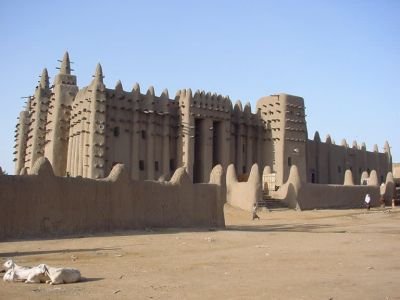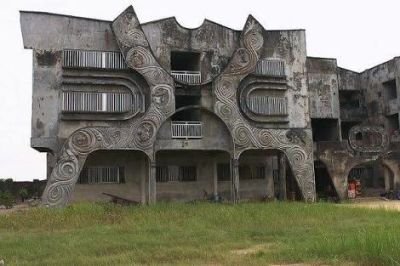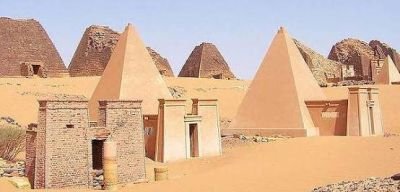
Alice Lane Towers ( Johannesburg, South Africa)
With a curved facade constructed out of concrete, glass and aluminum, the Alice Lane Towers are intended to demonstrate South Africa’s progression in exploring new forms within corporate architecture. The 17-story towers boasts being the first high-rise building in South Africa to use a curved and completely glazed facade, made with low-energy glass and state-of-the-art glass-printing technology. Viewed from all angles, the building, which was built in the suburbs of Johannesburg in 2010, presents a uniquely patterned and highly abstracted surface of architectural elements that change constantly with the time and atmosphere of the day.

The Great Mosque of Djenne (Djenne, Mali)
The Great Mosque of Djenné is a large banco or adobe building that is considered by many architects to be one of the greatest achievements of the Sudano-Sahelian architectural style. The mosque is located in the city of Djenné, Mali, on the flood plain of the Bani River. The first mosque on the site was built around the 13th century, but the current structure dates from 1907. As well as being the center of the community of Djenné, it is one of the most famous landmarks in Africa.

House in Warri, Nigeria
Few details are known about on this fascinating home in Warri, Nigeria, however images of the unfinished, unmaintained, yet still beautiful property have managed to wow those who have stumbled upon it online. The building embodies the blending of old and new, with traditional African artwork and shapes accenting a modern structure. It may serve as an example of how Africans can maintain the cultural themes present in their traditional architecture, even as the continent rapidly modernizes building techniques.

Pyramids of Giza (Al-Jīzah, Egypt)
Pyramids of Giza are the three 4th dynasty (c. 2575 – c. 2465 BCE) pyramids erected on the rocky plateau of the west bank of the Nile River near Al-Jīzah (Giza) in Egypt (formerly known as Kemet or Kmt). The designations of the pyramids — Khufu, Khafre, and Menkaure —correspond to the kings for whom they were built.
The northernmost and oldest pyramid of the group was built for Khufu, the second king of the 4th dynasty. Called the Great Pyramid, it is the largest of the three, with the length of each side at the base averaging 755.75 feet (230 meters) and its original height towering 481.4 feet (147 meters). Perhaps the most colossal single building ever erected on the planet, its sides rise at an angle of 51°52′ and are accurately oriented to the four cardinal points of the compass. Approximately 2.3 million blocks of stone were cut, transported and assembled to create the 5.75-million-ton structure, which is widely seen as a masterpiece of technical skill and engineering ability.

Nubian pyramids (Northern Sudan)
The Nubian pyramids were built from the fourth century B.C. to third century A.D. Nubia, which was known as Kush and is modern-day Sudan, rivaled its neighbor Egypt in wealth and power, and both empires mutually influenced each other. Nubia has 223 pyramids, doubling the number in Egypt. Prior to the Kushites building their pyramids, there had been no pyramid construction in Egypt and the Nile Valley for more than 500 years.
Built to house the bodies of kings and queens, the underground graves of the Nubian pyramids were richly decorated. They were all eventually plundered, most infamously by Italian explorer Giuseppe Ferlini (1800-1870) who smashed the tops from 40 pyramids in a quest for treasure in the 1820s.

**Cliff of Bandiagara (Land of the Dogons, Mali) **
The Cliff of Bandiagara, Land of the Dogons, is a vast cultural landscape of Mali. The sandstone cliff rises about 500 meters above the lower sandy plateau to the south. It has a length of approximately 150 kilometers. The area of the escarpment is inhabited today by the Dogon people. Their beautiful architecture (houses, granaries, altars, sanctuaries and Togu Na, or communal meeting-places) accent the regions exceptional geological and environmental features. It is extremely difficult to access, and the existence of a series of secret tunnels rendered it an effective means of defense for the Dogon in the face of formidable invaders. Thanks to this defensive shelter of buildings entrenched on the plateau and clinging to cliff faces, the Dogon were able to conserve their centuries-old culture and traditions. Their architecture has adapted to benefit from the physical constraints of the land and their exploitation of the all the available elements to build their villages reflect their ingenuity, making the Bandiagara dwellings one of Africa’s most impressive sites.
THANKS FOR READING
LIKE, COMMENT AND RESTEEM
Awesome post. Thanks for sharing!
You're very welcome
My Pleasure - Steem on!
wow... nice post
I have one word....WOOOOOOWWWWWWWWW!
Lol thanks
Lol thanks ☺